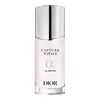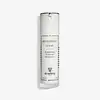What's inside
What's inside
 Key Ingredients
Key Ingredients

 Benefits
Benefits

 Concerns
Concerns

 Ingredients Side-by-side
Ingredients Side-by-side

Water
Skin ConditioningGlycerin
HumectantAlcohol
AntimicrobialButylene Glycol
HumectantSqualane
EmollientBetaine
HumectantLimnanthes Alba Seed Oil
Skin ConditioningPolyglycerin-3
HumectantLauroyl Lysine
Skin ConditioningIris Florentina Root Extract
MaskingMalva Sylvestris Extract
AstringentAframomum Angustifolium Seed Extract
Skin ConditioningJasminum Officinale Flower Extract
MaskingAdenosine
Skin ConditioningSodium Hyaluronate
HumectantSodium Tocopheryl Phosphate
AntioxidantPalmaria Palmata Extract
Skin ProtectingHydrolyzed Soy Protein
HumectantPropanediol
SolventPolyglycerin-6
HumectantHydrogenated Lecithin
EmulsifyingPullulan
Xylitol
HumectantParfum
MaskingChlorphenesin
AntimicrobialLecithin
EmollientYeast Ferment Extract
Skin ConditioningSodium Acetylated Hyaluronate
HumectantAlcaligenes Polysaccharides
EmollientLactobacillus Ferment Lysate
Skin ConditioningSodium Surfactin
CleansingPolysorbate 60
EmulsifyingSorbitan Isostearate
EmulsifyingSodium Benzoate
MaskingPotassium Sorbate
PreservativeTrisodium Ethylenediamine Disuccinate
CI 77491
Cosmetic ColorantSilica
AbrasiveTocopherol
AntioxidantHelianthus Annuus Seed Oil
EmollientPentylene Glycol
Skin ConditioningHydroxyethyl Acrylate/Sodium Acryloyldimethyl Taurate Copolymer
Emulsion StabilisingCaprylyl Glycol
EmollientWater, Glycerin, Alcohol, Butylene Glycol, Squalane, Betaine, Limnanthes Alba Seed Oil, Polyglycerin-3, Lauroyl Lysine, Iris Florentina Root Extract, Malva Sylvestris Extract, Aframomum Angustifolium Seed Extract, Jasminum Officinale Flower Extract, Adenosine, Sodium Hyaluronate, Sodium Tocopheryl Phosphate, Palmaria Palmata Extract, Hydrolyzed Soy Protein, Propanediol, Polyglycerin-6, Hydrogenated Lecithin, Pullulan, Xylitol, Parfum, Chlorphenesin, Lecithin, Yeast Ferment Extract, Sodium Acetylated Hyaluronate, Alcaligenes Polysaccharides, Lactobacillus Ferment Lysate, Sodium Surfactin, Polysorbate 60, Sorbitan Isostearate, Sodium Benzoate, Potassium Sorbate, Trisodium Ethylenediamine Disuccinate, CI 77491, Silica, Tocopherol, Helianthus Annuus Seed Oil, Pentylene Glycol, Hydroxyethyl Acrylate/Sodium Acryloyldimethyl Taurate Copolymer, Caprylyl Glycol
Water
Skin ConditioningDimethicone
EmollientTitanium Dioxide
Cosmetic ColorantGlycerin
HumectantCaprylyl Methicone
Skin ConditioningPolyglyceryl-3 Polydimethylsiloxyethyl Dimethicone
Skin ConditioningNiacinamide
SmoothingDimethicone/Vinyl Dimethicone Crosspolymer
Skin ConditioningAluminum Hydroxide
EmollientStearic Acid
CleansingPentylene Glycol
Skin ConditioningDicaprylyl Carbonate
EmollientMacadamia Integrifolia Seed Oil
Skin ConditioningPanthenol
Skin ConditioningTocopheryl Acetate
AntioxidantHexylresorcinol
AntimicrobialLens Esculenta Fruit Extract
Skin ConditioningPolygonum Fagopyrum Seed Extract
Skin ConditioningBisabolol
MaskingSucrose Dilaurate
EmollientRosa Canina Fruit Extract
AstringentPisum Sativum Extract
Skin ConditioningThymus Serpyllum Extract
Skin ConditioningLavandula Angustifolia Oil
MaskingThymus Mastichina Flower Oil
Skin ConditioningSalvia Officinalis Oil
MaskingButylene Glycol
HumectantPolyglyceryl-4 Isostearate
EmulsifyingCetyl PEG/PPG-10/1 Dimethicone
EmulsifyingHexyl Laurate
EmollientSodium Chloride
MaskingEthylhexylglycerin
Skin ConditioningStearalkonium Hectorite
Gel FormingSilica
AbrasiveDisodium EDTA
Citric Acid
BufferingPropylene Carbonate
SolventIsoceteth-10
EmulsifyingPolysorbate 20
EmulsifyingGlycine Soja Oil
EmollientCaprylyl Glycol
EmollientSodium Hydroxide
BufferingP-Anisic Acid
MaskingParfum
MaskingSorbic Acid
PreservativePhenoxyethanol
PreservativeSodium Benzoate
MaskingPotassium Sorbate
PreservativeTocopherol
AntioxidantLinalool
PerfumingLimonene
PerfumingAlpha-Isomethyl Ionone
PerfumingCitronellol
PerfumingCitral
PerfumingCoumarin
PerfumingGeraniol
PerfumingEugenol
PerfumingWater, Dimethicone, Titanium Dioxide, Glycerin, Caprylyl Methicone, Polyglyceryl-3 Polydimethylsiloxyethyl Dimethicone, Niacinamide, Dimethicone/Vinyl Dimethicone Crosspolymer, Aluminum Hydroxide, Stearic Acid, Pentylene Glycol, Dicaprylyl Carbonate, Macadamia Integrifolia Seed Oil, Panthenol, Tocopheryl Acetate, Hexylresorcinol, Lens Esculenta Fruit Extract, Polygonum Fagopyrum Seed Extract, Bisabolol, Sucrose Dilaurate, Rosa Canina Fruit Extract, Pisum Sativum Extract, Thymus Serpyllum Extract, Lavandula Angustifolia Oil, Thymus Mastichina Flower Oil, Salvia Officinalis Oil, Butylene Glycol, Polyglyceryl-4 Isostearate, Cetyl PEG/PPG-10/1 Dimethicone, Hexyl Laurate, Sodium Chloride, Ethylhexylglycerin, Stearalkonium Hectorite, Silica, Disodium EDTA, Citric Acid, Propylene Carbonate, Isoceteth-10, Polysorbate 20, Glycine Soja Oil, Caprylyl Glycol, Sodium Hydroxide, P-Anisic Acid, Parfum, Sorbic Acid, Phenoxyethanol, Sodium Benzoate, Potassium Sorbate, Tocopherol, Linalool, Limonene, Alpha-Isomethyl Ionone, Citronellol, Citral, Coumarin, Geraniol, Eugenol
 Reviews
Reviews

Ingredients Explained
These ingredients are found in both products.
Ingredients higher up in an ingredient list are typically present in a larger amount.
Butylene Glycol (or BG) is used within cosmetic products for a few different reasons:
Overall, Butylene Glycol is a safe and well-rounded ingredient that works well with other ingredients.
Though this ingredient works well with most skin types, some people with sensitive skin may experience a reaction such as allergic rashes, closed comedones, or itchiness.
Learn more about Butylene GlycolCaprylyl Glycol is a humectant and emollient, meaning it attracts and preserves moisture.
It is a common ingredient in many products, especially those designed to hydrate skin. The primary benefits are retaining moisture, skin softening, and promoting a healthy skin barrier.
Though Caprylyl Glycol is an alcohol derived from fatty acids, it is not the kind that can dry out skin.
This ingredient is also used as a preservative to extend the life of products. It has slight antimicrobial properties.
Learn more about Caprylyl GlycolGlycerin is already naturally found in your skin. It helps moisturize and protect your skin.
A study from 2016 found glycerin to be more effective as a humectant than AHAs and hyaluronic acid.
As a humectant, it helps the skin stay hydrated by pulling moisture to your skin. The low molecular weight of glycerin allows it to pull moisture into the deeper layers of your skin.
Hydrated skin improves your skin barrier; Your skin barrier helps protect against irritants and bacteria.
Glycerin has also been found to have antimicrobial and antiviral properties. Due to these properties, glycerin is often used in wound and burn treatments.
In cosmetics, glycerin is usually derived from plants such as soybean or palm. However, it can also be sourced from animals, such as tallow or animal fat.
This ingredient is organic, colorless, odorless, and non-toxic.
Glycerin is the name for this ingredient in American English. British English uses Glycerol/Glycerine.
Learn more about GlycerinParfum is a catch-all term for an ingredient or more that is used to give a scent to products.
Also called "fragrance", this ingredient can be a blend of hundreds of chemicals or plant oils. This means every product with "fragrance" or "parfum" in the ingredients list is a different mixture.
For instance, Habanolide is a proprietary trade name for a specific aroma chemical. When used as a fragrance ingredient in cosmetics, most aroma chemicals fall under the broad labeling category of “FRAGRANCE” or “PARFUM” according to EU and US regulations.
The term 'parfum' or 'fragrance' is not regulated in many countries. In many cases, it is up to the brand to define this term.
For instance, many brands choose to label themselves as "fragrance-free" because they are not using synthetic fragrances. However, their products may still contain ingredients such as essential oils that are considered a fragrance by INCI standards.
One example is Calendula flower extract. Calendula is an essential oil that still imparts a scent or 'fragrance'.
Depending on the blend, the ingredients in the mixture can cause allergies and sensitivities on the skin. Some ingredients that are known EU allergens include linalool and citronellol.
Parfum can also be used to mask or cover an unpleasant scent.
The bottom line is: not all fragrances/parfum/ingredients are created equally. If you are worried about fragrances, we recommend taking a closer look at an ingredient. And of course, we always recommend speaking with a professional.
Learn more about ParfumPentylene glycol is typically used within a product to thicken it. It also adds a smooth, soft, and moisturizing feel to the product. It is naturally found in plants such as sugar beets.
The hydrophilic trait of Pentylene Glycol makes it a humectant. As a humectant, Pentylene Glycol helps draw moisture from the air to your skin. This can help keep your skin hydrated.
This property also makes Pentylene Glycol a great texture enhancer. It can also help thicken or stabilize a product.
Pentylene Glycol also acts as a mild preservative and helps to keep a product microbe-free.
Some people may experience mild eye and skin irritation from Pentylene Glycol. We always recommend speaking with a professional about using this ingredient in your routine.
Pentylene Glycol has a low molecular weight and is part of the 1,2-glycol family.
Learn more about Pentylene GlycolPotassium Sorbate is a preservative used to prevent yeast and mold in products. It is commonly found in both cosmetic and food products.
This ingredient comes from potassium salt derived from sorbic acid. Sorbic acid is a natural antibiotic and effective against fungus.
Both potassium sorbate and sorbic acid can be found in baked goods, cheeses, dried meats, dried fruit, ice cream, pickles, wine, yogurt, and more.
You'll often find this ingredient used with other preservatives.
Learn more about Potassium SorbateSilica, also known as silicon dioxide, is a naturally occurring mineral. It is used as a fine, spherical, and porous powder in cosmetics.
Though it has exfoliant properties, the function of silica varies depending on the product.
The unique structure of silica enhances the spreadability and adds smoothness, making it a great texture enhancer.
It is also used as an active carrier, emulsifier, and mattifier due to its ability to absorb excess oil.
In some products, tiny microneedles called spicules are made from silica or hydrolyzed sponge. When you rub them in, they lightly polish away dead skin layers and enhance the penetration of active ingredients.
Learn more about SilicaSodium Benzoate is a preservative. It's used in both cosmetic and food products to inhibit the growth of mold and bacteria. It is typically produced synthetically.
Both the US FDA and EU Health Committee have approved the use of sodium benzoate. In the US, levels of 0.1% (of the total product) are allowed.
Sodium benzoate works as a preservative by inhibiting the growth of bacteria inside of cells. It prevents the cell from fermenting a type of sugar using an enzyme called phosphofructokinase.
It is the salt of benzoic acid. Foods containing sodium benzoate include soda, salad dressings, condiments, fruit juices, wines, and snack foods.
Studies for using ascorbic acid and sodium benzoate in cosmetics are lacking, especially in skincare routines with multiple steps.
We always recommend speaking with a professional, such as a dermatologist, if you have any concerns.
Learn more about Sodium BenzoateTocopherol (also known as Vitamin E) is a common antioxidant used to help protect the skin from free-radicals and strengthen the skin barrier. It's also fat soluble - this means our skin is great at absorbing it.
Vitamin E also helps keep your natural skin lipids healthy. Your lipid skin barrier naturally consists of lipids, ceramides, and fatty acids. Vitamin E offers extra protection for your skin’s lipid barrier, keeping your skin healthy and nourished.
Another benefit is a bit of UV protection. Vitamin E helps reduce the damage caused by UVB rays. (It should not replace your sunscreen). Combining it with Vitamin C can decrease sunburned cells and hyperpigmentation after UV exposure.
You might have noticed Vitamin E + C often paired together. This is because it is great at stabilizing Vitamin C. Using the two together helps increase the effectiveness of both ingredients.
There are often claims that Vitamin E can reduce/prevent scarring, but these claims haven't been confirmed by scientific research.
Learn more about TocopherolWater. It's the most common cosmetic ingredient of all. You'll usually see it at the top of ingredient lists, meaning that it makes up the largest part of the product.
So why is it so popular? Water most often acts as a solvent - this means that it helps dissolve other ingredients into the formulation.
You'll also recognize water as that liquid we all need to stay alive. If you see this, drink a glass of water. Stay hydrated!
Learn more about Water